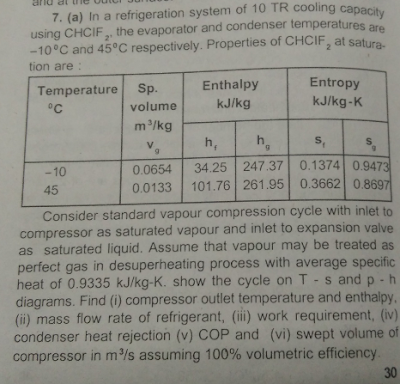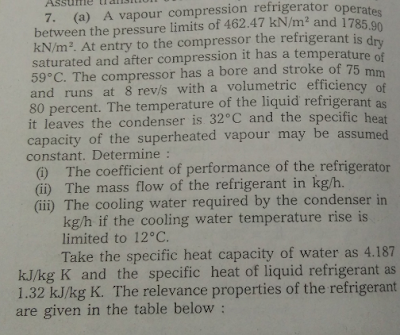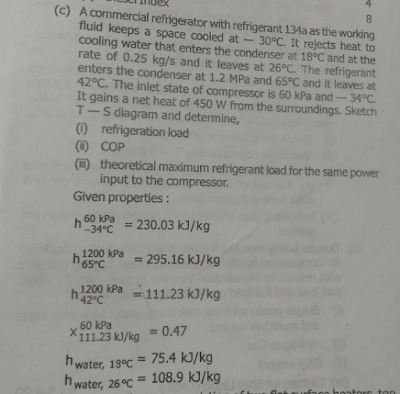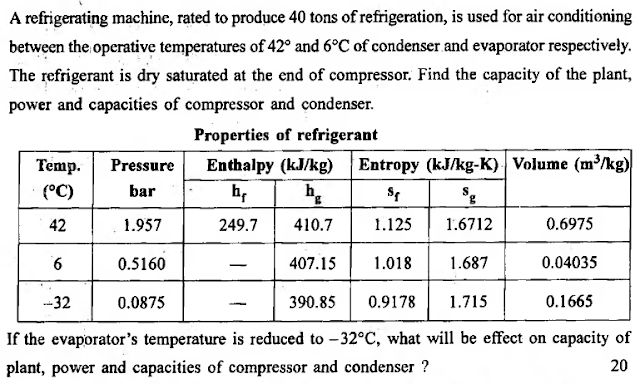Refrigeration and Air conditioning
1kcal=4.186kJ=3.968Btu, 1Btu=1.055kJ
Ton refgn 1TR is equivalent to production of cold at rate at which heat is to be removed from 1 US tonne of water at 32degF to freeze it to ice at 32degF in 1 day(24 hours)
1TR=200Btu/min=3.5167kW
Ways of producing low temperatures
*throttling expansion of liquid with flashing
*reversible adiabatic expansion of a gas[T2/T1 = (p2/p1)^(γ-1 / γ)]
*irreversible adiabatic expansion(throttling) of real gas[Joule Kelvin effect]
*thermoelectric cooling[Peltier effect]
*adiabatic demagnetization of a paramagnetic salt
Reverse Carnot cycle
VC cycle
CSE2003B7a30

CSE2004B7a40

CSE2006B6a30
CSE2006B5b20
CSE2008B5d20
CSE2010B6b20

CSE2012B7c20
CSE2013A1e10

CSE2015B7a20
LVHE
CSE2007A3a30
CSE2008B7b15
Refrigerants properties, coding
Multistage and cascading systems
CSE2005B5b20
Compressors
CSE2010B5d20
Condensers
CSE2009B7c25
CSE2015B6c10
Expansion valves
CSE2011B5a15
CSE2011B6c20
CSE2015B5a10
Gas cycles(Joule or reversed Brayton)
CSE2013B8b25
VA system
CSE2010B7b20
Moist air properties
CSE2008B7a15
CSE2011B5b15
CSE2014B6c10
Psychrometry of AC processes
CSE2007A3b30
CSE2008B7c30
CSE2009B8b20
CSE2010B8c20
CSE2012A3c20
CSE2013B5d10
CSE2013B8a25
CSE2015B6a20
Comfort AC and ET
CSE2003B7b30
CSE2005B7a40
CSE2006A1c20
CSE2006B6b30
CSE2009B5d20
CSE2009B8a40
CSE2011B7b30
CSE2014B7b20/2004B5b20
CSE2014B5d10
1kcal=4.186kJ=3.968Btu, 1Btu=1.055kJ
Ton refgn 1TR is equivalent to production of cold at rate at which heat is to be removed from 1 US tonne of water at 32degF to freeze it to ice at 32degF in 1 day(24 hours)
1TR=200Btu/min=3.5167kW
Ways of producing low temperatures
*throttling expansion of liquid with flashing
*reversible adiabatic expansion of a gas[T2/T1 = (p2/p1)^(γ-1 / γ)]
*irreversible adiabatic expansion(throttling) of real gas[Joule Kelvin effect]
*thermoelectric cooling[Peltier effect]
*adiabatic demagnetization of a paramagnetic salt
Reverse Carnot cycle
VC cycle
CSE2003B7a30

CSE2004B7a40

CSE2006B6a30
CSE2006B5b20
CSE2008B5d20
CSE2010B6b20

CSE2012B7c20
CSE2013A1e10

CSE2015B7a20
LVHE
CSE2007A3a30
CSE2008B7b15
Refrigerants properties, coding
Multistage and cascading systems
CSE2005B5b20
Compressors
CSE2010B5d20
Condensers
CSE2009B7c25
CSE2015B6c10
Expansion valves
CSE2011B5a15
CSE2011B6c20
CSE2015B5a10
Gas cycles(Joule or reversed Brayton)
CSE2013B8b25
VA system
CSE2010B7b20
Moist air properties
CSE2008B7a15
CSE2011B5b15
CSE2014B6c10
Psychrometry of AC processes
CSE2007A3b30
CSE2008B7c30
CSE2009B8b20
CSE2010B8c20
CSE2012A3c20
CSE2013B5d10
CSE2013B8a25
CSE2015B6a20
Comfort AC and ET
CSE2003B7b30
CSE2005B7a40
CSE2006A1c20
CSE2006B6b30
CSE2009B5d20
CSE2009B8a40
CSE2011B7b30
CSE2014B7b20/2004B5b20
CSE2014B5d10






















sir..can u plz solve 6a of 2015 mains...aor atleast give some hints...is it a case for sensible heating & cooling and humidification??? how to loacte 110 deg temp in psy chart..i dont think it would be reqd..so plz give some hint..
ReplyDeletei left this question in exam because I too was confused on locating 110degC on chart :D , besides AC was never my strong area. But now it makes sense, that the question is about the 3 equations of balance--dry air mass flow, moisture balance and energy balance(enthalpy). No need to locate points on chart. I'll try to put up solution soon, till then see where you reach with this approach. Categorizing the type of process is difficult(for me), so I wouldnt go there, Id prefer going straight to equations..
Deleteyes yes.. first confused abt 110..but then i also went through thes eqns balance...as this type of Qs(not xact) is given in schand rac book..i tried also and solved something..so just want to go through ur soln as i hv some specific doubt..u can directly solve the problem..no problem..i can understand..thanku..
Deleteand also sir if u could solve the "ESE 2014:PAPER-1:Q1(h)"..i couldnt find this type of problem f thermostatic xpansion valve nywhere in any book...so plz suggest the source also for solving this type of proble..coz its coming now a days...
ReplyDeleteI think it is given in CP Arora. Alternatively, you can refer to Pg 25 in http://nptel.ac.in/courses/112105129/pdf/R&AC%20Lecture%2024.pdf
DeleteNow for ESE2014-1h, Te=7degC, superheat(deltaTs)=5 degC, so Pp=psat at 7+5=12degC = 443.01kPa, Pe=psat at Te=374.63kPa
so, spring pressure Ps=Pp-Pe=443.01-374.63=68.38kPa, now Te'=-23degC, pe'=116.39, so Pp'=ps+pe'=184.77, corresponding Tp is about -12degC, so new degree of superheat is about 11deg
Baki more on TEV: http://www.danfoss.com/NR/rdonlyres/CA5E4257-4F6B-4F41-A268-8CB4FE6874DD/0/PFA00A102.pdf
thanx for the reply..actually i dont follow arora..i hv schand book and rajput...thanx for the pdfs..is it reqd to follow arora?? actually the above 2 books hv enough xampls and simple language..thats why i foloow them..
DeleteI have found that this site is very informative, interesting and very well written. keep up the nice high quality writing. Professional Essay Writers
ReplyDelete